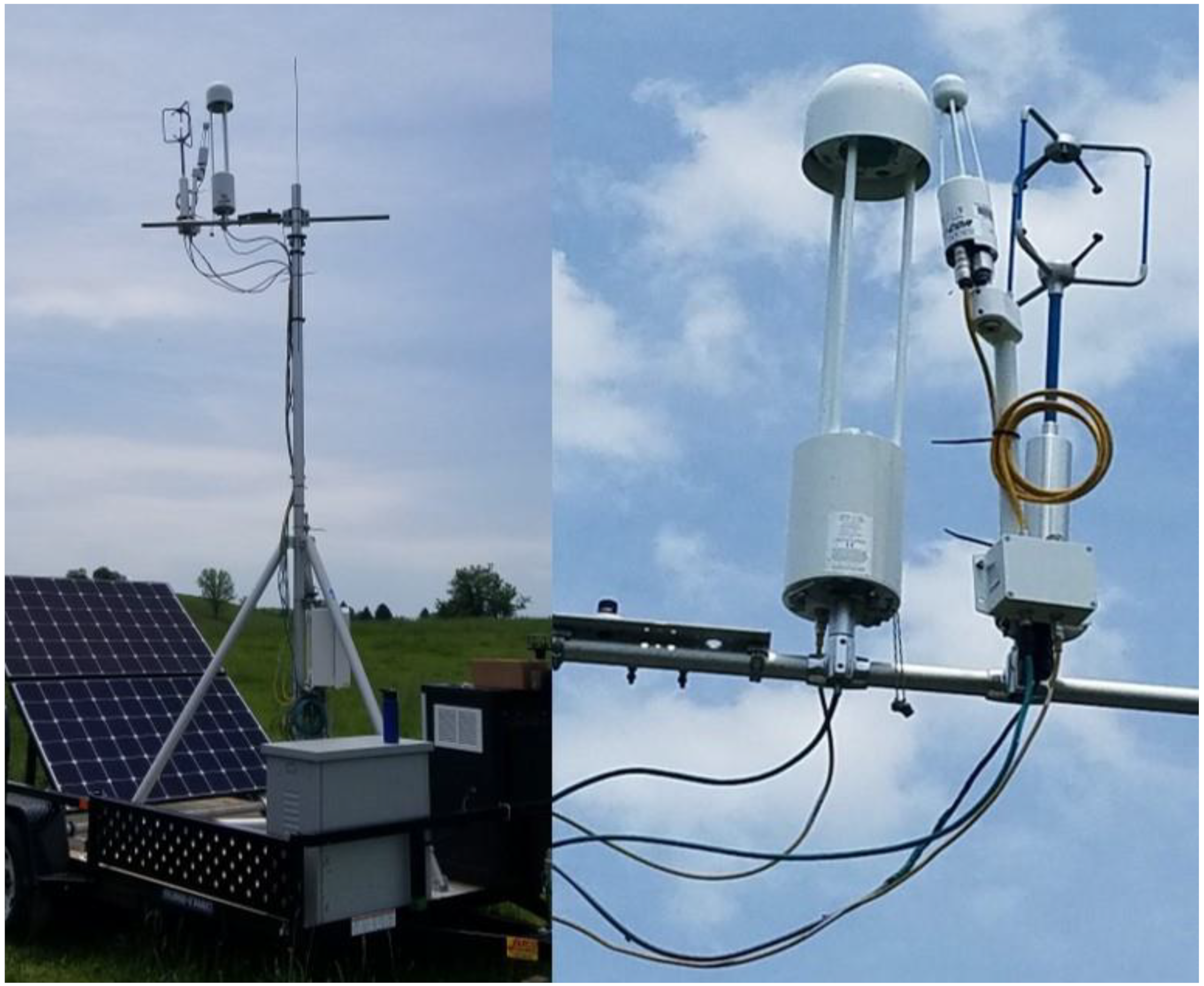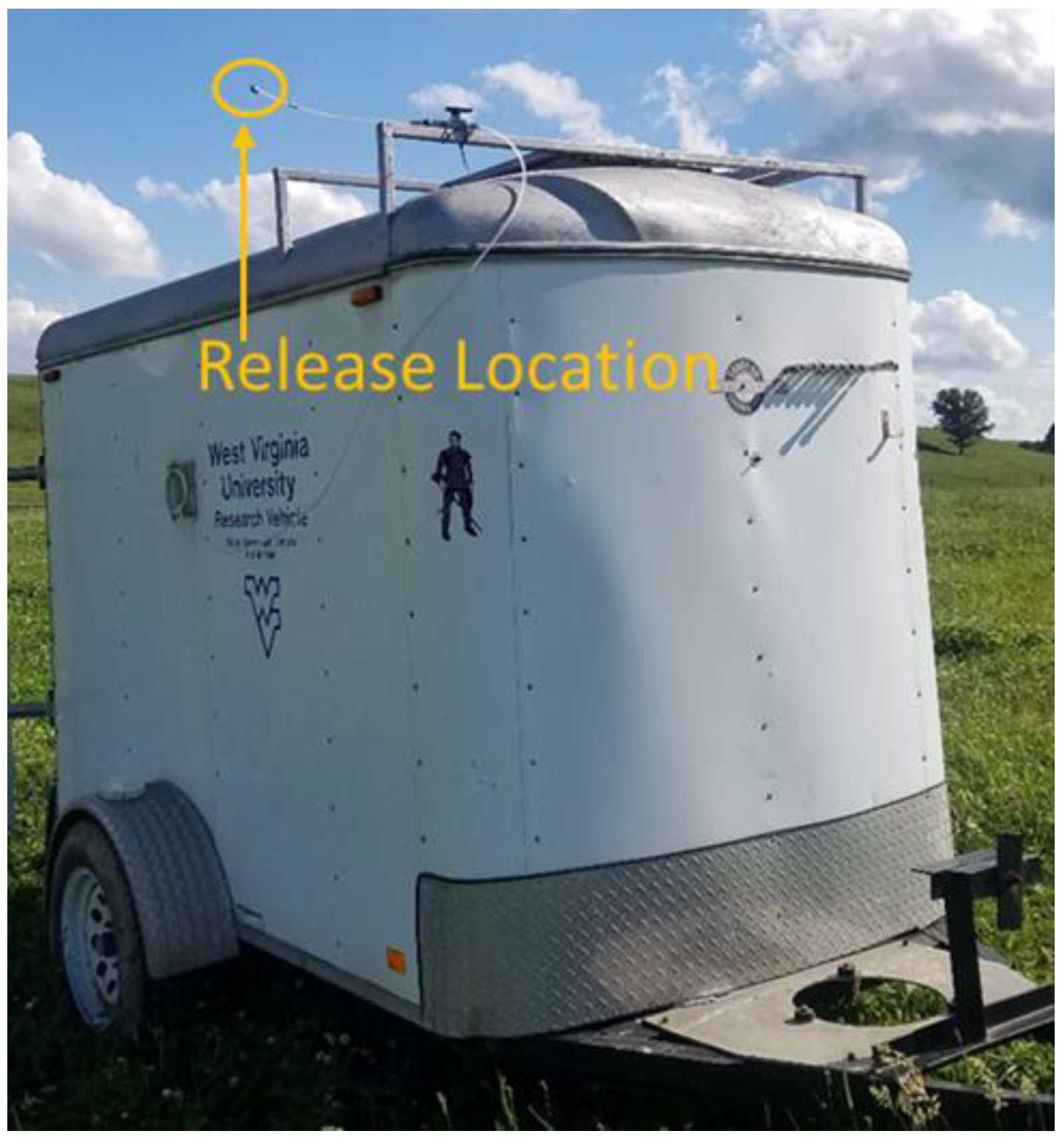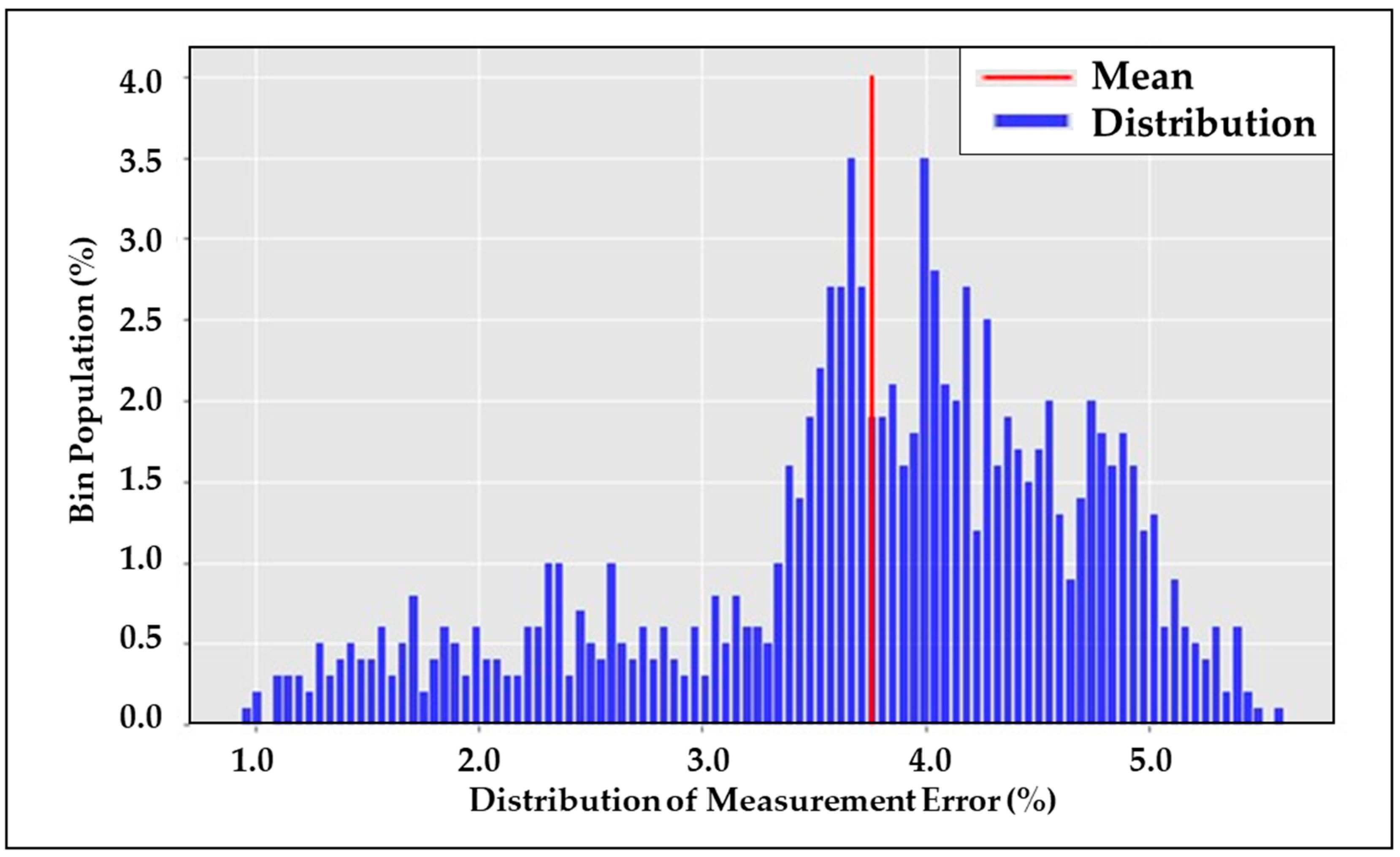Understanding the Accuracy Limitations of Quantifying Methane Emissions Using Other Test Method 33A
Abstract
:1. Introduction
2. Materials and Methods
3. Results and Discussion
3.1. Instrument Uncertainty
- measured value = the value reported and recorded form the instrument
- upper value = measured value + standard uncertainty of measured value
- lower value = measured value − standard uncertainty of measured value
- The percentage of the measured estimate was calculated for each of the 729 results for each period.
- From these 729 results, a single estimate was randomly selected 100 times to represent the given period.
- The mean, standard deviation (σ), and standard error (SE) of these periods were calculated. The SE was calculated using Equation (2), where n represents the number of samples (100).
- The measurement uncertainty of the 100 samples was calculated as [±1.96 * SE] representing the 95% confidence interval (CI) of the standard normal distribution.
- This process was repeated for 1000 iterations and the average measurement uncertainty was determined to be the measurement uncertainty for all estimates.
3.2. Method Uncertainty
- -
- Photosynthetic Photon Flux Density (PPFD) difference less than 75 µmol/m2s
- -
- Air Temperature Difference less than 3 °C
- -
- Vapor Pressure Deficit Difference less than 200 Pa (0.2 kPa)
- -
- Wind Speed Difference less than 1 m/s
- -
- No precipitation between periods
- -
- Air Temperature difference less than 3 °C
- -
- PPFD difference less than 75 µmol/m2s
- -
- Wind speed difference less than 1 m/s
3.3. Instrument Uncertainy Results
3.4. Method Uncertainy Results
4. Conclusions
Supplementary Materials
Author Contributions
Funding
Institutional Review Board Statement
Informed Consent Statement
Data Availability Statement
Conflicts of Interest
Appendix A
| Device | Manufacturer | Detection Method | Max Rate/ Used Rate | Parameters Measured | Range | Resolution (res)/Accuracy (acc) | Operating Limits |
|---|---|---|---|---|---|---|---|
| Gill WindMaster | Gill Instruments Ltd. (Hampshire, UK) | Ultrasonic Pulse | 20 Hz/ 10 Hz | 3-D Wind Speed | 0–50 m/s | <1.5% RMS | T: −40–70 °C |
| RH: <5–100% | |||||||
| LI-7700 | LI-COR Biosciences (Lincoln, NE, USA) | Wavelength Modulation Spectroscopy | 20 Hz/ 10 Hz | CH4 conc. TemperaturePressure | CH4: 0–40 ppm at 25 °C | 5 ppb res.<1% linearity | T: −25–50 °C |
| P: 50–110 kPa | |||||||
| RH: 0–100% | |||||||
| LI-7500 | LI-COR Biosciences (Lincoln, NE, USA) | Non-dispersive spectroscopy | 20 Hz/ 10 Hz | CO2 conc. H2O conc. Temperature Pressure | CO2: 0–3000 µmol/mol | CO2: <1% of reading | RH: 0–95% |
| H2O: 0–60 µmol/mol | H2O: <1% of reading | ||||||
| T: −20–70 °C | T: ±0.3 °C | T: −25–50 °C | |||||
| P: 50–110 kPa | P: 0.4 kPa | P: 50–110 kPa | |||||
| LI-200R | LI-COR Biosciences (Lincoln, NE, USA) | Photovoltaic | 1 × 105 Hz/ 10 Hz | Solar Loading | 0–3000 W/m2 | ±3% over reading | T: −40–65 °C |
| RH: 0–100% | |||||||
| Omega iBTHx | Omega™ Engineering (Norwalk, CT, USA) | Various | 0.25 Hz/ 0.25 Hz | Temperature Pressure Relative Humidity | T: 0–70 °C | T: ±2 °C acc. 0.01 °C res. | T: 0–70 °C |
| P: 0–110 kPa | P: ±0.2 kPa acc.0.01 kPa res. | P: 0–110 kPa | |||||
| RH: 0–100% | RH: 2% for 10–90 acc. 0.03% res. | RH: 0–100% |

| Release Rates (g/s) | Distances (m) | ||
|---|---|---|---|
| 0.036 | 42 | 72 | 119 |
| 0.119 | 57 | 72 | 119 |
| 0.239 | 42 | 72 | 119 |

- The resolution of the LI-7700 is 5 parts per billion (ppb). The half interval in ppm is then 0.005.
- 2.
- The accuracy of the analyzer is 1% of the reading across the full calibration range. So, if the concentration is 2.0945 ppm.
- 3.
- The total uncertainty is the sum of the squares of the resolution and accuracy uncertainty.
References
- Miller, S.; Wofsy, S.; Michalak, A.; Sweeny, C. Anthropogenic Emissions of Methane in the United States. Proc. Natl. Acad. Sci. USA 2013, 110, 20018–20022. [Google Scholar] [CrossRef] [PubMed] [Green Version]
- Omara, M.; Zimmerman, N.; Sullivan, M.; Li, X.; Ellis, A.; Cesa, R.; Subramanian, R.; Presto, A.; Robinson, A. Methane Emissions from Natural Gas Production Sites in the United States: Data Synthesis and National Estimate. Environ. Sci. Technol. 2018, 42, 12915–12925. [Google Scholar] [CrossRef] [PubMed] [Green Version]
- Zavala-Araiza, D.; Lyon, D.; Alvarez, R.; Hamburg, S. Reconciling Divergent Estimates of Oil and Gas Methane Emissions. Proc. Natl. Acad. Sci. USA 2015, 112, 15597–15602. [Google Scholar] [CrossRef] [PubMed] [Green Version]
- Kimbrel, D.; Balasbas, J.; Zolnierek, J.; Fallah, J.; Thibodeaux, C. Sampling of Methane Emissions Detection Technologies and Practices for Natural Gas Distribution Infrastructure; National Association of Regulatory Utility Commissioners: Washington, DC, USA; Available online: https://pubs.naruc.org/pub/0CA39FB4-A38C-C3BF-5B0A-FCD60A7B3098 (accessed on 9 March 2021).
- Jakober, C.; Mara, S.; Hsu, Y.K.; Herner, J. Mobile Measurements of Climate Forcing Agents: Application to Methane Emissions from Landfill and Natural Gas Compression. J. Air Waste Manag. Assoc. 2015, 65, 404–412. [Google Scholar] [CrossRef] [PubMed] [Green Version]
- Omara, M.; Sullivan, M.; Li, X.; Subramanian, R.; Robinson, A.; Presto, A. Methane Emissions from Conventional and Unconventional Natural Gas Production Sites in the Marcellus Shale Basin. Environ. Sci. Technol. 2016, 50, 2099–2107. [Google Scholar] [CrossRef] [PubMed]
- Bell, C.; Vaughn, T.; Zimmerle, D.; Herndon, S.; Yacovitch, T.; Heath, G.; Petron, G.; Edie, R.; Field, R.; Murphy, S.; et al. Comparison of Methane Emission Estimates from Multiple Measurement Techniques at Natural Gas Production Pads. Elem. Sci. Anthr. 2017, 5, 79. [Google Scholar] [CrossRef] [Green Version]
- Thoma, E.D.; Brantley, H.; Squier, B.; DeWees, J.; Segall, R.; Merrill, R. Development of Mobile Measurement Method Series. In Proceedings of the 108th Annual Conference of the Air & Waste Management Association (AWMA), Raleigh, NC, USA, 23–26 June 2015; p. 15. [Google Scholar]
- Brantley, H.L.; Thoma, E.D.; Squier, W.C.; Guven, B.B.; Lyon, D. Assessment of Methane Emissions from Oil and Gas Production Pads using Mobile Measurements. Environ. Sci. Technol. 2014, 48, 14508–14515. [Google Scholar] [CrossRef] [PubMed] [Green Version]
- Edie, R.; Robertson, A.M.; Field, R.A.; Soltis, J.; Snare, D.A.; Zimmerle, D.; Bell, C.S.; Vaughn, T.L.; Murphy, S.M. Constraining the accuracy of flux estimates using OTM 33A. Atmos. Meas. Tech. 2020, 13, 341–353. [Google Scholar] [CrossRef] [Green Version]
- Heltzel, R.S.; Zaki, M.T.; Gebreslase, A.K.; Abdul-Aziz, O.I.; Johnson, D.R. Continuous OTM 33A Analysis of Controlled Releases of Methane with Various Time Periods, Data Rates and Wind Filters. Environments 2020, 7, 65. [Google Scholar] [CrossRef]
- Robertson, A.M.; Edie, R.; Snare, D.; Soltis, J.; Field, R.A.; Burkhart, M.D.; Bell, C.S.; Zimmerle, D.; Murphy, S.M. Variation in Methane Emission Rates from Well Pads in Four Oil and Gas Basins with Contrasting Production Volumes and Compositions. Environ. Sci. Technol. 2017, 51, 8832–8840. [Google Scholar] [CrossRef] [PubMed]
- OTM 33A V1.3. Environmental Protection Agency. 2014. Available online: https://www3.epa.gov/ttnemc01/prelim/otm33a.pdf (accessed on 1 January 2020).
- Albertson, J.; Harvey, T.; Foderaro, G.; Zhu, P.; Zhou, X.; Ferrari, S.; Sharooz Amin, M.; Modrak, M.; Brantley, H.; Thoma, E.D. Mobile Sensing Approach for Regional Surveillance of Fugitive Methane Emissions in Oil and Gas Production. Environ. Sci. Technol. 2016, 50, 2487–2497. [Google Scholar] [CrossRef] [PubMed] [Green Version]
- Yacovitch, T.; Herndon, S.; Petron, G.; Kofler, J.; Lyon, D.; Zahnizer, M.; Kolb, C. Mobile Laboratory Observations of Methane Emission in the Barnett Shale Region. Environ. Sci. Technol. 2015, 49, 7889–7895. [Google Scholar] [CrossRef] [PubMed]
- Lin, X.; Talbot, R.; Laine, P.; Torres, A. Characterizing Fugitive Methane Emissions in the Barnett Shale Area Using a Mobile Laboratory. Environ. Sci. Technol. 2015, 49, 8139–8146. [Google Scholar] [CrossRef] [PubMed]
- Heltzel, R.; Johnson, D.; Zaki, M.; Gebreslase, A.; Abdul-Aziz, O.I. Machine Learning Techniques to Increase the Performance of Indirect Methane Quantification from a Single, Stationary Sensor. Heyilon, 2022; under review. [Google Scholar]
- Hollinger, D.Y.; Richardson, A.D. Uncertainty in eddy covariance measurements and its application to physiological models. Tree Physiol. 2005, 25, 873–885. [Google Scholar] [CrossRef] [PubMed] [Green Version]
- Gill Instruments Limited WindMaster 3-Axis Ultrasonic Anemometer. Available online: http://www.gillinstruments.com/products/anemometer/windmaster.htm (accessed on 2 January 2020).
- LI-COR LI-7700. LI-COR Biosciences. Available online: https://www.licor.com/env/support/LI-7700/manuals.html (accessed on 8 March 2021).
- LI-COR LI-7500. LI-COR Biosciences. Available online: https://www.licor.com/env/support/LI-7500/home.html (accessed on 8 March 2021).
- Omega iBTHx. Available online: https://in.omega.com/pptst/IBTX_IBTHX.html (accessed on 9 March 2021).
- LI-COR LI-200R Pyranometer. Available online: https://www.licor.com/env/products/light/pyranometer (accessed on 28 August 2020).
- Heltzel, R.S. On the Improvement of the Indirect Quantification of Methane Emissions: A Stationary Single Sensor Approach; West Virginia University: Morgantown, WV, USA, 2021. [Google Scholar]
- J.W. Ruby Research Farm. Davis College of Agriculture, Natural Resources and Design, West Virginia University. Available online: https://www.davis.wvu.edu/about-davis-college/farms-and-forests/j-w-ruby-research-farm (accessed on 8 March 2021).
- Johnson, D.; Heltzel, R.; Oliver, D. Temporal Variations in Methane Emissions from an Unconventional Well Site. ACS Omega 2019, 4, 3708–3715. [Google Scholar] [CrossRef] [PubMed] [Green Version]
- Johnson, D.; Heltzel, R. On the Long-Term Temporal Variations in Methane Emissions from an Unconventional Natural Gas Well Site. ACS Omega 2021, 6, 14200–14207. [Google Scholar] [CrossRef] [PubMed]
- MSEEL. Available online: http://mseel.org/ (accessed on 2 January 2020).
- Probability Distributions for Measurement Uncertainty. Available online: https://www.isobudgets.com/probability-distributions-for-measurement-uncertainty/ (accessed on 8 March 2021).
- How to Calculate Resolution Uncertainty. Available online: https://www.isobudgets.com/calculate-resolution-uncertainty/ (accessed on 8 March 2021).
- Estimating Measurement Uncertainty. Available online: https://www.sml-inc.com/uncertainy.htm (accessed on 8 March 2021).
- Yamulki, S.; Jarvis, S.C.; Owen, P. Methane Emission and Uptake from Soils as Influenced by Excreta Deposition from Grazing Animals. J. Environ. Qual. 1999, 28, 676–682. [Google Scholar] [CrossRef]
- Koehn, A.C.; Leytem, A.B.; David, L. Bjorneberg Comparison of Atmospheric Stability Methods for Calculating Ammonia and Methane Emission Rates with WindTrax. Trans. ASABE 2013, 56, 763–768. [Google Scholar] [CrossRef]
- Environmental Growth Chambers. Available online: http://www.egc.com/useful_info_lighting.php (accessed on 9 March 2021).

| Distance (m) | Release Rate (g/s) | ||||
|---|---|---|---|---|---|
| None | 0.036 | 0.119 | 0.239 | Total | |
| 42 | 577 | 234 | 110 | 38 | 382 |
| 57 | 224 | - | 47 | 34 | 81 |
| 72 | 289 | 63 | 100 | - | 163 |
| 119 | 118 | 98 | 68 | 12 | 178 |
| Total | 1208 | 395 | 325 | 84 | 804 |
| Robertson et al. | Edie et al. | Brantley et al. | This Work | |
|---|---|---|---|---|
| Count (#) | 19 | 24 | 107 | 181 |
| Release Rates (g/s) | 0.03–0.56 | 0.04–0.6 | 0.19–1.2 | 0.04–0.24 |
| Full Range of % Error | −75% to 60% | −60% to 175% | −60% to 52% | −95% to 1070% |
| Tests within ±30% Error | - | - | 71% | 30% |
| Tests within ±50% Error | 85% | - | 56% | |
| 68th Percentile Error | ±28% | ±38% | - | ±64% |
| Device | Relevant Variable | Acronym | Resolution | Accuracy |
|---|---|---|---|---|
| Gill WindMaster | X wind speed | u | ±0.01 m/s | <1.5% RMS |
| Y wind speed | v | |||
| Z wind speed | w | |||
| LI-7700 | Methane Concentration | ch4 | ±0.005 ppm | <1% |
| LI-7500 | Temperature | t | ±0.003 K | ±0.3 K |
| Pressure | p | ±0.06 mbar | ±4 mbar |
| Distance (m) for Calculation | σ (x1 − x2) | σ (δq) | 95% CI | Mean Estimate of Periods | 95% CI/Mean Estimate |
|---|---|---|---|---|---|
| [g/s] | [g/s] | [±g/s] | [g/s] | [%] | |
| 42 | 0.007 | 0.005 | 0.001 | 0.007 | 17% |
| 57 | 0.012 | 0.008 | 0.002 | 0.012 | 17% |
| 72 | 0.018 | 0.012 | 0.003 | 0.018 | 17% |
| 119 | 0.045 | 0.032 | 0.008 | 0.045 | 17% |
| Quantification Method | Uncertainty Method | How It Is Presented | Result |
|---|---|---|---|
| OTM | Instrument Measurement Uncertainty | The range of uncertainty as a percentage of the OTM estimate for any period based on the uncertainty of the instruments used to record data. | ±3.8% |
| OTM | Modified H&R 24 h Difference Method | The range of measurement uncertainty of the method due to randomness in the measurement. | ±17% |
| OTM | Combined Uncertainty | The minimal possible uncertainty from the OTM method, calculated as the combined uncertainty of the other two methods. | ±17.4% |
Publisher’s Note: MDPI stays neutral with regard to jurisdictional claims in published maps and institutional affiliations. |
© 2022 by the authors. Licensee MDPI, Basel, Switzerland. This article is an open access article distributed under the terms and conditions of the Creative Commons Attribution (CC BY) license (https://creativecommons.org/licenses/by/4.0/).
Share and Cite
Heltzel, R.; Johnson, D.; Zaki, M.; Gebreslase, A.; Abdul-Aziz, O.I. Understanding the Accuracy Limitations of Quantifying Methane Emissions Using Other Test Method 33A. Environments 2022, 9, 47. https://doi.org/10.3390/environments9040047
Heltzel R, Johnson D, Zaki M, Gebreslase A, Abdul-Aziz OI. Understanding the Accuracy Limitations of Quantifying Methane Emissions Using Other Test Method 33A. Environments. 2022; 9(4):47. https://doi.org/10.3390/environments9040047
Chicago/Turabian StyleHeltzel, Robert, Derek Johnson, Mohammed Zaki, Aron Gebreslase, and Omar I. Abdul-Aziz. 2022. "Understanding the Accuracy Limitations of Quantifying Methane Emissions Using Other Test Method 33A" Environments 9, no. 4: 47. https://doi.org/10.3390/environments9040047
APA StyleHeltzel, R., Johnson, D., Zaki, M., Gebreslase, A., & Abdul-Aziz, O. I. (2022). Understanding the Accuracy Limitations of Quantifying Methane Emissions Using Other Test Method 33A. Environments, 9(4), 47. https://doi.org/10.3390/environments9040047







